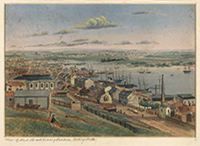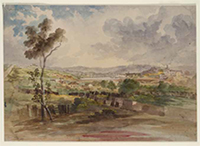The History of Pyrmont
Pyrmont contained a mineral spring of cold water bubbling out of a rock and was thus named for a similar natural spring in Bad Pyrmont, close to Hanover, Germany. The area was also the site of the first Presbyterian Church in the colony, built in 1864 and situated in Mount Street. The congregation eventually outgrew the premises and had to move to a new church at Quarry Street, Ultimo.
Aboriginal culture
Before European settlement the Eora tribe of Indigenous Australians inhabited the area. Their Aboriginal name for this area was 'Pirrama', which is still the name of a road on the Pyrmont waterfront.
European settlement
Thomas Jones was granted 55 acres (22 ha) of land on the peninsula in 1795. Land was sold to Obadiah Ikin in 1796 for 10 pounds, which he then sold to Captain John Macarthur in 1799 for a gallon of rum. Pyrmont quarries provided sandstone for many of Sydney's 19th century buildings. The first Pyrmont Bridge opened in 1858. A larger bridge with a swinging span opened in 1902.
Pyrmont became a working class industrial and port community. A major sugar refinery was operated by CSR Limited
Decay
Pyrmont was considered to be a slum area in the 19th century. It started to decay after World War II, when industries closed down, and the residents moved to other suburbs. In 1963 the Ultimo Powerhouse closed down as well.
Redevelopment in the 1990s
In order to rejuvenate the area the government initiated the Better Cities Program. In 1992 the City West Development Corporation was created with the mission to renew the precinct. In 1999 this responsibility was transferred to the Sydney Harbour Foreshore Authority.
This led to a larger community of 13,000 by 2004 and also an increase of trade with businesses moving back into the area, totaling 22,000 employees. Almost all industrial function is gone from the area now, replaced by low and high-rise residential developments.
Following the redevelopment the suburb became more multicultural, with only 35% of residents born in Australia.
Landmarks
Pyrmont Fire Station in Pyrmont Street was designed by the Government Architect, Walter Liberty Vernon, in 1907. It is an example of the Federation Free Style, predominantly made of brick with sandstone trimmings, and with Art Nouveau elements. It is now on the Register of the National Estate.
The public school in John Street was designed by W.E.Kemp and built in 1891; a brick building, it features a bell tower, belfry and slate roof, and is on the Register of the National Estate
Union Square is a major heritage precinct. It includes the Post Office in Harris Street, the Harlequin Inn pub, two bank buildings in Union Street, the homes from 4-20 Union Street, all buildings from 99-125 Harris Street, the terrace from 135-141 Harris Street and terraces from 1-21 Paternoster Row. All of these buildings are listed on the Register of the National Estate. Also on the Register is the Waite and Bull building at 137 Pyrmont Bridge Road.
HISTORICAL IMAGES OF PYRMONT








